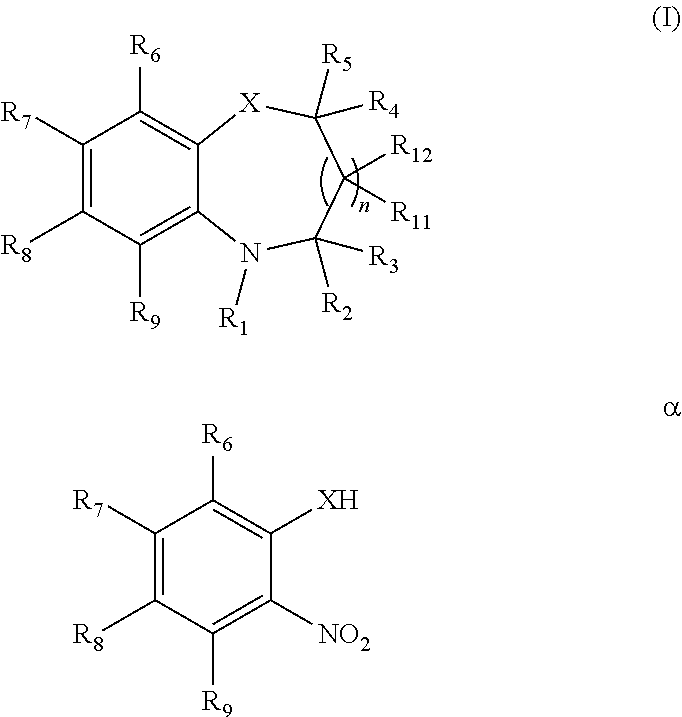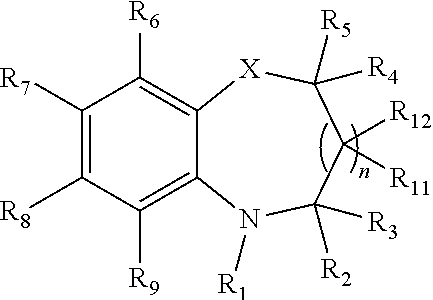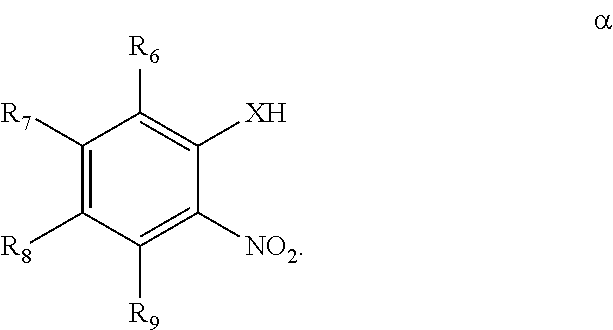Methods for Preparing Fuel Additives
- Summary
- Abstract
- Description
- Claims
- Application Information
AI Technical Summary
Benefits of technology
Problems solved by technology
Method used
Image
Examples
example 1
Preparation of Fuel Additive e According to Embodiment (1)
[0221]In step (i), the following intermediate c was prepared using a variety of reagents b:
[0222]In a first experiment, bromonitrile was used as reagent b. Specifically, 2-nitrophenol (10.0 g, 72 mmol), bromoacetonitrile (0.9 eq) and K2CO3 (2 eq) were refluxed in acetonitrile for 20 hours. The solvent was evaporated and the residue was partitioned between water and ethyl acetate, the organic layer washed three times with an aqueous solution of K2CO3. The organic phase was dried over sodium sulphate, the solvent was removed in vacuo and the residue was triturated with hexane to give 11.1 g (86% yield) of intermediate c as a light green solid.
[0223]In a second experiment, chloronitrile was used as reagent b. Specifically, 2-nitrophenol (10.0 g, 72 mmol), chloroacetonitrile (0.9 eq) and K2CO3 (2 eq) were refluxed in acetonitrile for 20 hours. The solvent was evaporated and the residue was partitioned between water and ethyl acet...
example 2
Preparation of Fuel Additive e According to Embodiment (2)
[0233]In step (i), the following intermediate c was prepared using a variety of reagents b:
[0234]In a first experiment, chlorobromoethane was used as reagent b. Specifically, a mixture of 2-nitrophenol (5.0 g), chlorobromoethane (4 eq) and K2CO3 (2 eq) was heated at reflux in MeCN (100 ml) for 2.5 hours, the solvent was evaporated and partitioned between ethyl acetate and water. The organic phase was dried over sodium sulphate, the solvent was evaporated and the residue was triturated with hexane to give 6.8 g (94% yield) of intermediate c as a light yellow solid.
[0235]In a second experiment, dibromoethane was used as reagent b. Specifically, a mixture of 2-nitrophenol (10.0 g, 72 mmol), dibromoethane (5 eq) and K2CO3 (2 eq) was refluxed in acetonitrile (200 ml) for 2 hours. The reaction mixture was partitioned between water and diethyl ether, the organic layer was dried over sodium sulphate, evaporated and re-dissolved in a ...
example 3
Preparation of Fuel Additive e According to Embodiment (3)
[0251]In step (i), the following intermediate c was prepared:
[0252]Bromoacetaldehyde diethylacetal was used as reagent b. Specifically, a mixture of 2-nitrophenol (5.0 g, 36 mmol), bromoacetaldehyde diethylacetal (1 eq) and K2CO3 (1 eq) was heated in NMP (30 ml) to 120° C. for 16 hours, then cooled to ambient temperature, added to aq K2CO3 and extracted into diethylether. The organic phase was washed three times with aq K2CO3, dried over sodium sulphate and evaporated in vacuo to give 8.5 g (92% yield) of intermediate c as an orange oil.
[0253]In an alternative step (i), the following intermediate c was prepared:
[0254]Chloroacetaldehyde dimethylacetal was used as reagent b. Specifically, a mixture of 4-methyl-2-nitrophenol (20.0 g), chloroacetaldehyde dimethylacetal (1.3 eq), NaI (0.1 eq) and K2CO3 (1.1 eq) was heated in NMP (4 vol) to 110-150° C. for 3 days to give 97% yield of crude intermediate c. A similar experiment was s...
PUM
 Login to view more
Login to view more Abstract
Description
Claims
Application Information
 Login to view more
Login to view more - R&D Engineer
- R&D Manager
- IP Professional
- Industry Leading Data Capabilities
- Powerful AI technology
- Patent DNA Extraction
Browse by: Latest US Patents, China's latest patents, Technical Efficacy Thesaurus, Application Domain, Technology Topic.
© 2024 PatSnap. All rights reserved.Legal|Privacy policy|Modern Slavery Act Transparency Statement|Sitemap



